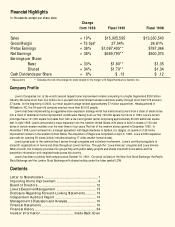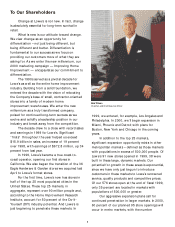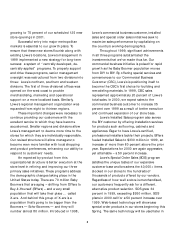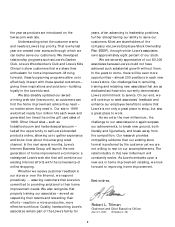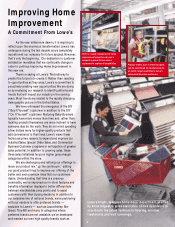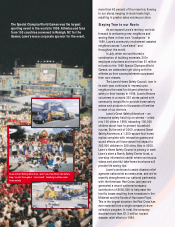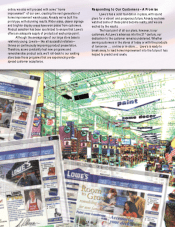Lowe's 1999 Annual Report Download - page 3
Download and view the complete annual report
Please find page 3 of the 1999 Lowe's annual report below. You can navigate through the pages in the report by either clicking on the pages listed below, or by using the keyword search tool below to find specific information within the annual report.
1
To Our Shareholders
Bob Tillman
Chairman and Chief Executive Officer
Change at Lowe’s is not new. In fact, change
is absolutely essential for long-term survival in
retail.
What is new is our attitude toward change.
We view change as an opportunity for
differentiation – not just being different, but
being different and better. Differentiation is
fundamental to our success as w e focus on
providing our customers more of w hat they are
asking for. As w e enter the new millennium, our
2000 marketing campaign — Improving Home
Improvement — encapsulates our commitment to
differentiation.
The 1990s served as a pivotal decade for
Lowe’s as well as the entire home improvement
industry. Building from a solid foundation, w e
entered the decade w ith the vision of relocating
the Company’s base of small, contractor-oriented
stores into a family of modern home
improvement w arehouses. We enter the new
millennium as a truly transformed company,
poised for continued long-term success as we
evolve and solidify a leadership position in our
industry and break away from the competition.
The decade drew to a close w ith record sales
and earnings in 1999 for Low e’s. Significant
“ firsts” throughout the year helped us exceed
$15.9 billion in sales, an increase of 19 percent
over 1998, w ith earnings of $672.8 million, up 34
percent from last year.
In 1999, Lowe’s became a true coast-to-
coast operator, opening our first stores in
California. We also began the transition of the 36
Eagle Hardware & Garden stores w e acquired last
April to Low e’s format stores.
For the first time, Lowe’s now has stores in
half of the top 25 most populated cities in the
United States. These top 25 markets, in
aggregate, represent over 90 million people and,
according to the Home Improvement Research
Institute, account for 50 percent of the Do-It-
Yourself (DIY) industry potential. And Lowe’s is
just beginning to penetrate these markets. In
1999, w e entered, for example, Los Angeles and
Philadelphia. In 2000, we’ll begin expansion in
M iami, Phoenix and Detroit with plans for
Boston, New York and Chicago in the coming
years.
In addition to the top 25 markets,
significant expansion opportunity exists in other
metropolitan markets – defined as those markets
w ith populations in excess of 500,000 people. Of
Lowe’s 91 new stores opened in 1999, 38 w ere
built in these large, dynamic markets. Our
potential for growth in these areas is exponential,
since w e have only just begun to introduce
customers in these markets to Lowe’s renow ned
service, quality products and competitive prices.
Of our 576 stores open at the end of fiscal 1999,
only 35 percent are located in markets with
populations of 500,000 or greater.
Our aggressive expansion plans call for
continued penetration in larger markets. In 2000,
60 percent of our planned 95 store openings w ill
occur in metro markets, w ith the number


